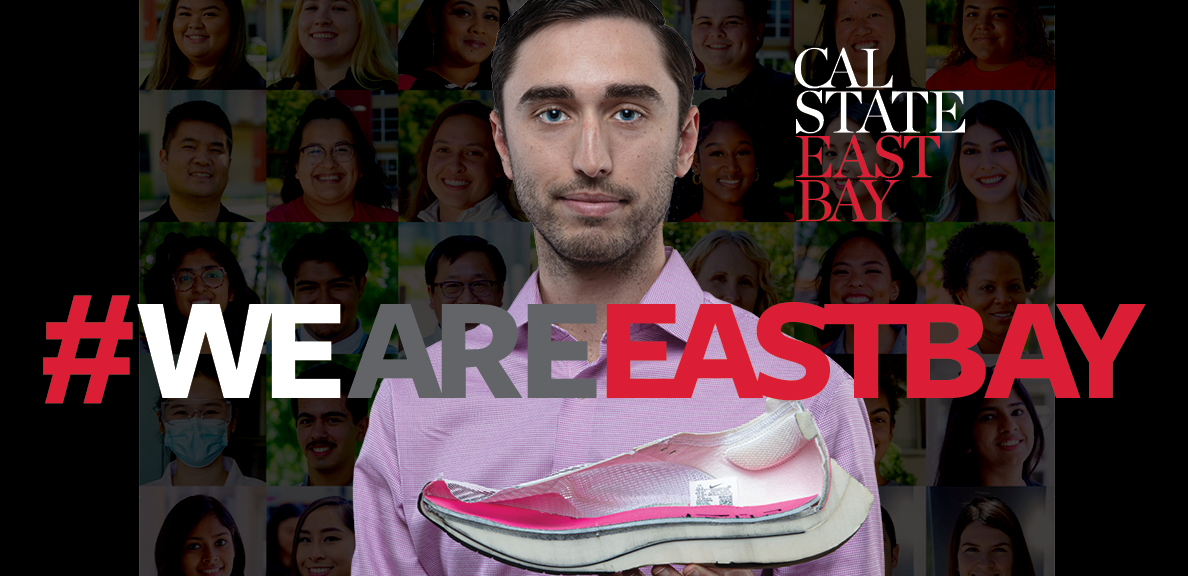
To the Runners: Don’t be afraid to race toward the unknown
BY Kimberly Hawkins
PHOTOGRAPHY BY Garvin Tso | Graphic Design by Gus Yoo
May 8, 2024
Justin Matties can give Mariah Carey and DJ Khaled a run for their money when it comes to caring about shoes. For him, running shoes are a tool and using them in the right way might be the difference between placing on the cross-country podium or walking home empty-handed.
“I am conducting research on the long-term effects of training in carbon-plated ‘super shoes’ versus traditional racing flats on physiological and biomechanical adaptations in competitive cross-country runners,” said Matties.
He chose Cal State East Bay because of the cross country and track program. He stayed because of Professor Michael Rowley who inspired him as an undergrad to continue on for his master’s in kinesiology. Matties will be graduating May 9 at 5 p.m. in the ceremony for the College of Education and Allied Studies.
“For years I didn't think I needed to go to office hours, but office hours aren’t just for class help,” said Matties. “My footwear research journey started by going to Dr. Rowley’s office hours and talking about my interest in running shoes. One office hours visit has completely changed my academic and professional journeys for the best.”
Matties’s research is inspired by his own use of super shoes — high-tech sneakers designed to be lightweight, responsive and fast. He, like many other runners, initially reserved these shoes for racing due to their low durability and high cost. Still, he wanted to know if using them during training would affect recovery and performance.
“I wanted to know if this innovative shoe technology, which improves a runner’s efficiency by about 4%, reduces mechanical demands at the ankle and toe joints, and reduces muscular soreness, potentially stunts positive training adaptations or allows for improved recovery that helps runners train at a higher level,” said Matties. “Since I was interested in biomechanics, I was also curious if runners who trained in super shoes were able to ‘learn’ how to use super shoes more effectively, measured by changes in their biomechanics and acute super shoe performance benefits.”
“Justin's training intervention study was incredibly ambitious and involved two years of study, talking with 68 potential participants, acquiring 72 pairs of shoes, and conducting 56 data collections,” said Rowley. “There is a reason no one has yet published a longitudinal study like this on super shoes - because it is an incredible amount of work. Justin's contributions to the field have already created a buzz in academic and sport communities and are inspiring new training methods among runners.”
Matties, who has been featured in Outside Magazine and whose research was grant-funded by the Nike Sport Research Lab, hopes his work can help inform runners, coaches and footwear companies about the long-term effects of using super shoes. He will continue his biomechanics research in the Ph.D. program at UMass at Amherst.
“We in the Kinesiology Department are proud and excited for Justin to continue his education and training under Katherine Boyer, a world-renowned biomechanist at UMass Amherst, and eventually to work in the footwear design industry,” said Rowley. “I expect within a decade or so, we will be hearing about some brand-new innovative shoe design Justin has patented. Justin will always have a home in our department, and we wish him luck as he moves on to bigger and better opportunities!”
Topics
Share this story